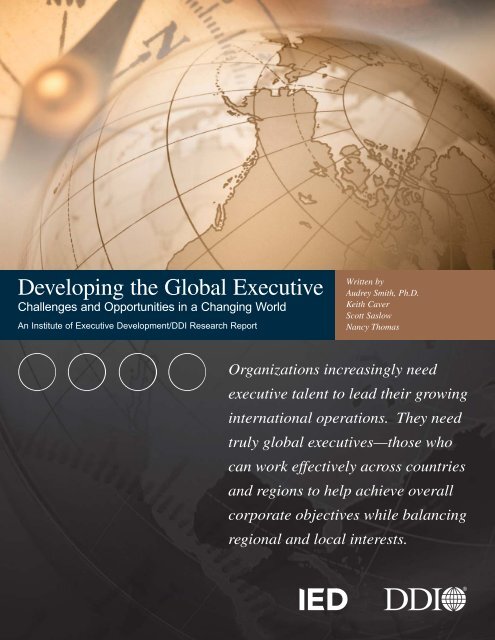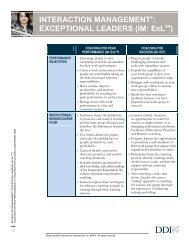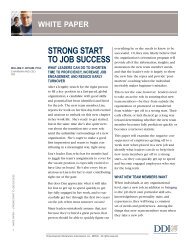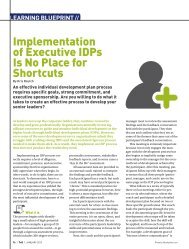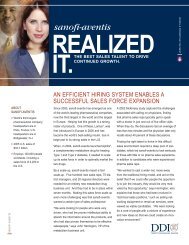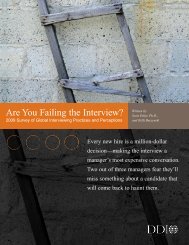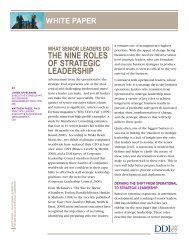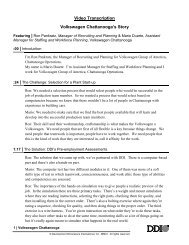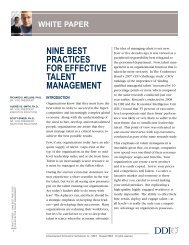Developing the Global Executive - Development Dimensions ...
Developing the Global Executive - Development Dimensions ...
Developing the Global Executive - Development Dimensions ...
You also want an ePaper? Increase the reach of your titles
YUMPU automatically turns print PDFs into web optimized ePapers that Google loves.
<strong>Developing</strong> <strong>the</strong> <strong>Global</strong> <strong>Executive</strong><br />
Challenges and Opportunities in a Changing World<br />
An Institute of <strong>Executive</strong> <strong>Development</strong>/DDI Research Report<br />
Written by<br />
Audrey Smith, Ph.D.<br />
Keith Caver<br />
Scott Saslow<br />
Nancy Thomas<br />
Organizations increasingly need<br />
executive talent to lead <strong>the</strong>ir growing<br />
international operations. They need<br />
truly global executives—those who<br />
can work effectively across countries<br />
and regions to help achieve overall<br />
corporate objectives while balancing<br />
regional and local interests.
<strong>Developing</strong> <strong>the</strong> <strong>Global</strong> <strong>Executive</strong><br />
Challenges and Opportunities in a Changing World<br />
An Institute of <strong>Executive</strong> <strong>Development</strong>/DDI Research Report<br />
Written by<br />
Audrey Smith, Ph.D.<br />
Keith Caver<br />
Scott Saslow<br />
Nancy Thomas<br />
Audrey Smith, Ph.D., is senior vice president, executive solutions,<br />
for DDI. Audrey and her team spearhead DDI’s global consulting<br />
resources to help organizations identify, develop, and deploy<br />
executive-level talent. Her expertise includes talent management<br />
strategy and execution, talent assessment, accelerated<br />
development, performance management/accountability systems,<br />
culture change consulting, and o<strong>the</strong>r executive team interventions<br />
that link strategy to execution. A recognized thought leader in<br />
executive succession management, Audrey co-authored Grow Your<br />
Own Leaders.<br />
Keith Caver is president of Caver Consulting and is a sought-after<br />
speaker and thought leader in <strong>the</strong> area of talent strategy,<br />
organizational transformation, diversity, and various subjects<br />
regarding executive leadership. Prior to his current role, Keith<br />
was DDI’s vice president and global practice leader of executive<br />
development and was director, custom solutions, for <strong>the</strong> Center for<br />
Creative Leadership. Among his many works, Keith is <strong>the</strong> co-author<br />
of Leading in Black and White: Working Across <strong>the</strong> Racial Divide in<br />
Corporate America.<br />
Scott Saslow is <strong>the</strong> executive director of The Institute of <strong>Executive</strong><br />
<strong>Development</strong>, which provides custom services and technology to<br />
help organizations advance <strong>the</strong>ir leader development, and is a<br />
leading exchange of unbiased information, best practices, and<br />
innovative ideas in leadership and executive development.<br />
Nancy Thomas of The Institute of <strong>Executive</strong> <strong>Development</strong> consults<br />
to client organizations about leader development strategies and<br />
practices, and manages <strong>the</strong> firm’s research and benchmarking<br />
studies. Her background includes 17 years at Hewlett-Packard,<br />
where she oversaw <strong>the</strong> development and implementation of global<br />
executive and high-potential programs.
4<br />
<strong>Developing</strong> <strong>the</strong> <strong>Global</strong> <strong>Executive</strong><br />
Introduction<br />
The number of global executive leaders is substantive.<br />
DDI’s <strong>Global</strong> Leadership Forecast, a study of more<br />
than 12,000 leaders across 76 countries, found that<br />
18% of all leaders and 37% of executives had<br />
multinational responsibilities. The executives<br />
coordinated efforts across an average of 8.5 countries<br />
(Howard & Wellins, 2008).
The requirements for multinational leaders can be daunting. <strong>Global</strong><br />
executives need <strong>the</strong> same knowledge and capabilities as domestic executives, as<br />
well as special attributes and skills to deal in unknown and often radically different<br />
cultures and environments. Given this reality, <strong>the</strong> need for special development<br />
programs for global executives seems clear. Yet <strong>the</strong> typical program to meet <strong>the</strong>se<br />
needs is still woefully inadequate.<br />
62% of <strong>the</strong> multinational executives described <strong>the</strong>ir preparation for <strong>the</strong>ir<br />
global roles as fair or poor in <strong>the</strong> <strong>Global</strong> Leadership Forecast.<br />
47% of <strong>the</strong> executives in this study described both <strong>the</strong> quality of<br />
<strong>the</strong> content and effectiveness of <strong>the</strong> execution of <strong>the</strong>ir global executive<br />
development programs as low or very low.<br />
In part, what makes <strong>the</strong> development of global executives so challenging are both<br />
<strong>the</strong> quantity and diversity of roles and capabilities associated with success in global<br />
leadership positions. It’s now old news that most every business today is a global<br />
business and those executives, as a major responsibility of <strong>the</strong>ir jobs, are required to<br />
“lead across borders” and play central roles in formulating and executing strategy on<br />
a global scale.<br />
<strong>Developing</strong> <strong>the</strong> <strong>Global</strong> <strong>Executive</strong><br />
5<br />
<strong>Developing</strong> <strong>the</strong> <strong>Global</strong> <strong>Executive</strong>
6<br />
<strong>Developing</strong> <strong>the</strong> <strong>Global</strong> <strong>Executive</strong><br />
The demands on organizations to effectively develop <strong>the</strong>ir current and<br />
future global executives have, in many respects, outpaced most organizations’ ability<br />
to provide that development. This is especially true as executive development must<br />
be transformational ra<strong>the</strong>r than incremental. Thus, <strong>the</strong> significant gaps alluded to in<br />
<strong>the</strong> figures cited on page 5. <strong>Global</strong> executives today are not getting <strong>the</strong> development<br />
<strong>the</strong>y require, placing both <strong>the</strong> executives—and <strong>the</strong>ir organizations—at risk of failure.<br />
However, organizations have realized that <strong>the</strong>y cannot expect to execute ambitious<br />
global business strategies if <strong>the</strong>y do not have <strong>the</strong> needed quality and quantity of<br />
leadership talent—especially talent that can succeed in challenging and critical global<br />
executive roles.<br />
The global economic downturn that began in 2008 has served to reorder priorities in<br />
many organizations. An intense focus on business strategies, financial issues, and<br />
operational goals takes precedence. Unfortunately, this reordering has, in many<br />
instances, resulted in a lessened emphasis on developing organizational talent—<br />
even critically important global leadership talent. Forward-looking organizations,<br />
meanwhile, have recognized <strong>the</strong> necessity of a continued, or even an intensified,<br />
focus on talent in order to ensure future organizational viability and success, and are<br />
continuing to invest in talent development initiatives.
ABOUT THE STUDY<br />
This study, conducted by <strong>Development</strong> <strong>Dimensions</strong> International (DDI) and The<br />
Institute of <strong>Executive</strong> <strong>Development</strong> (IED), examined what it takes to be a successful<br />
global executive, and <strong>the</strong> strategies and methods organizations use to develop <strong>the</strong>m.<br />
The purpose of this study was to learn more about how to design and carry out<br />
effective development programs that can meet <strong>the</strong> pressing needs of <strong>the</strong> growing<br />
body of global executives. The findings underscore significant challenges, but also<br />
bring to light some things that organizations can do to close <strong>the</strong> gap between <strong>the</strong><br />
development global executives need and <strong>the</strong> development—or lack <strong>the</strong>reof—that<br />
<strong>the</strong>y currently receive.<br />
An online survey, posted on <strong>the</strong> DDI and IED websites and sent directly to DDI’s and<br />
IED’s contact databases, was distributed to organizations with global operations.<br />
<strong>Executive</strong> development/talent professionals and HR executives (EDPs) as well as<br />
executives with global responsibilities were invited to respond. <strong>Global</strong> executives<br />
were defined as those at <strong>the</strong> director level and above with responsibility for<br />
operations in multiple countries. In addition to <strong>the</strong> survey, one-on-one interviews<br />
were conducted with a subset of survey respondents in order to ga<strong>the</strong>r additional<br />
qualitative insights and perspectives to support <strong>the</strong> survey data.<br />
<strong>Developing</strong> <strong>the</strong> <strong>Global</strong> <strong>Executive</strong><br />
7<br />
<strong>Developing</strong> <strong>the</strong> <strong>Global</strong> <strong>Executive</strong>
8<br />
<strong>Developing</strong> <strong>the</strong> <strong>Global</strong> <strong>Executive</strong><br />
FINDINGS AT A GLANCE<br />
1. The primary globalization business challenge is expanding from a local to a<br />
global business. (page 10)<br />
2. Preparing emerging leaders for global roles most often drives <strong>the</strong> development<br />
strategy. (page 11)<br />
3. <strong>Global</strong> executives are not getting <strong>the</strong> development <strong>the</strong>y need. (page 11)<br />
4. The highest quality programs had specific global competencies. (page 13)<br />
5. Ability to influence people from o<strong>the</strong>r cultures is <strong>the</strong> most important global<br />
competency. (page 15)<br />
6. Understanding government and political issues in key areas is essential for<br />
global executives. (page 16)<br />
7. Expatriate assignments, external networking, and internal mentoring were <strong>the</strong><br />
most effective methods for developing global executives. (page 18)<br />
8. The highest quality programs use more development methods. (page 20)<br />
9. Only 11% of global executives called <strong>the</strong> CEO/executive team active champions<br />
of <strong>the</strong>ir development. (page 22)<br />
10. Top-level support was strongly related to <strong>the</strong> effectiveness of program<br />
execution. (page 25)<br />
11. EDPs described global executive development as best integrated with<br />
high-potential development and succession planning. (page 26)<br />
12. Integration of global executive development with high-potential programs had<br />
<strong>the</strong> most positive impact on program execution. (page 27)<br />
13. Almost half of organizations do not measure <strong>the</strong>ir global executive development<br />
programs. (page 29)<br />
14. Quantitative measurement is highly related to successful program execution.<br />
(page 30)
EXPAT ASSIGNMENTS<br />
As Hartford Life International continues to expand globally, leaders in <strong>the</strong> corporate<br />
function must be more astute at thinking globally and better equipped to manage in a<br />
global economy. At <strong>the</strong> same time, <strong>the</strong>re is a desire to provide more support to those<br />
managing operations and growth in a local country with strategies for sourcing local<br />
talent and developing future leaders in that environment.<br />
The organization has relied heavily on expat assignments for global leader<br />
development, often sending in an expat to grow a local business. Expat assignments<br />
are viewed as <strong>the</strong> epitome of on-<strong>the</strong>-job training for global leaders and a good way to<br />
integrate development with real work. However, not everything is transferable from<br />
<strong>the</strong> U.S. to o<strong>the</strong>r locations and cultures, and one key to successful expat<br />
assignments lies in <strong>the</strong> selection process.<br />
One has to be wary of people whose leadership style is “I know this will work<br />
because it worked where I was before,” especially if <strong>the</strong>ir experience has only been<br />
in <strong>the</strong> U.S. and is limited to just one functional area. True global leaders need to be<br />
able to read <strong>the</strong> local environment, be sensitive to <strong>the</strong> local culture, and open to<br />
new ways of getting things done. Not only is adaptability to different cultures and<br />
leadership styles critical, <strong>the</strong> most successful expat candidates are those who exhibit<br />
a natural curiosity, interest in doing global work, and openness to personal change.<br />
<strong>Developing</strong> <strong>the</strong> <strong>Global</strong> <strong>Executive</strong><br />
9
10<br />
FINDING 1<br />
<strong>Developing</strong> <strong>the</strong> <strong>Global</strong> <strong>Executive</strong><br />
WHAT IS THE STATUS OF GLOBAL<br />
EXECUTIVE DEVELOPMENT TODAY?<br />
The primary globalization business challenge is expanding<br />
from a local to a global business.<br />
The majority of EDPs cited <strong>the</strong> shortage of global executive talent as <strong>the</strong> primary<br />
business challenge related to globalization faced by <strong>the</strong>ir organization (Figure 1).<br />
<strong>Executive</strong>s, constituting a much smaller sample, cited readiness to expand as <strong>the</strong><br />
primary challenge. This reflects <strong>the</strong>ir different vantage points—while EDPs are<br />
struggling to identify potential global leaders, global leaders are struggling with <strong>the</strong><br />
organization’s readiness to expand <strong>the</strong> business globally (a struggle also echoed<br />
by EDPs).<br />
Their divergent viewpoints would appear to reinforce a long-assumed disconnect<br />
between <strong>the</strong> priorities of HR and executives when it comes to talent. Instead, it could<br />
be argued that EDPs and executives are indeed on <strong>the</strong> same page, it’s just that <strong>the</strong>ir<br />
focus is on different points on a single line connecting business strategy with talent<br />
strategy. If <strong>the</strong> two strategies are properly aligned, <strong>the</strong> identification and subsequent<br />
development of global leadership talent will effectively grow <strong>the</strong> organization’s<br />
capability to expand globally.<br />
FIGURE 1: PRIMARY GLOBALIZATION CHALLENGE<br />
Demand vs. supply of<br />
global executive talent<br />
Readiness to expand from<br />
local to global business<br />
Fur<strong>the</strong>r expand regions<br />
where already doing business<br />
Managing growth<br />
through acquisitions<br />
New global competitors<br />
entering <strong>the</strong> marketplace<br />
O<strong>the</strong>r<br />
8%<br />
6%<br />
4% 6%<br />
8%<br />
8%<br />
17%<br />
21%<br />
25%<br />
25%<br />
35%<br />
0% 10% 20% 30% 40%<br />
EDPs Execs<br />
39%
Preparing emerging leaders for global roles most often drives<br />
<strong>the</strong> development strategy.<br />
The impetus behind <strong>the</strong> development strategy is <strong>the</strong> need to address <strong>the</strong> current<br />
shortcomings of leaders, when it comes to <strong>the</strong>ir overall effectiveness and <strong>the</strong>ir<br />
readiness for global roles (Figure 2). While this is a supremely important focus, it’s<br />
relatively narrow in scope, overlooking o<strong>the</strong>r important factors that have traditionally<br />
driven leadership development programs, such as consistency, balance, and<br />
retention. Perhaps this is because of <strong>the</strong> relatively new focus on global development.<br />
FIGURE 2: PRIMARY FACTOR DRIVING GLOBAL LEADERSHIP DEVELOPMENT STRATEGY<br />
Prepare emerging leaders<br />
for global roles<br />
Improve leadership<br />
effectiveness overall<br />
Enhance execution of<br />
global business strategy<br />
Enhance skills of current<br />
global executives<br />
Drive consistent focus/<br />
direction across regions<br />
Balance company-wide policies<br />
and practices with local needs<br />
O<strong>the</strong>r<br />
Retain current global<br />
executives<br />
Establish consistent image/<br />
brand for leaders<br />
0%<br />
1% 3%<br />
1%<br />
0%<br />
2%<br />
8%<br />
8%<br />
4% 8%<br />
10%<br />
11%<br />
<strong>Global</strong> executives are not getting <strong>the</strong> development <strong>the</strong>y need.<br />
Both EDPs and executives were asked to rate <strong>the</strong>ir global development programs on<br />
two criteria on a five-point scale (very low to very high):<br />
Content (Quality of design; curriculum covers <strong>the</strong> right issues)<br />
Execution (Effectiveness of execution; program has impact)<br />
Their responses are shown in Figure 3.<br />
18%<br />
17%<br />
22%<br />
24%<br />
31%<br />
34%<br />
0% 10% 20% 30% 40%<br />
EDPs Execs<br />
FINDING 2<br />
FINDING 3<br />
<strong>Developing</strong> <strong>the</strong> <strong>Global</strong> <strong>Executive</strong><br />
11<br />
<strong>Developing</strong> <strong>the</strong> <strong>Global</strong> <strong>Executive</strong>
12<br />
<strong>Developing</strong> <strong>the</strong> <strong>Global</strong> <strong>Executive</strong><br />
FIGURE 3: EXECUTIVES’ RATINGS OF THEIR GLOBAL EXECUTIVE DEVELOPMENT PROGRAMS<br />
100%<br />
90%<br />
80%<br />
70%<br />
60%<br />
50%<br />
40%<br />
30%<br />
20%<br />
10%<br />
0%<br />
25%<br />
28%<br />
28%<br />
19%<br />
Quality<br />
of Content<br />
Effectiveness<br />
of Execution<br />
<strong>Executive</strong>s were overall quite negative about <strong>the</strong>ir development programs.<br />
As mentioned earlier, nearly half rated both content and execution very low or low.<br />
Execution is evaluated somewhat worse than content overall: 25% rated <strong>the</strong> content<br />
of <strong>the</strong>ir programs high or very high compared to only 17% for execution.<br />
The low regard in which executives hold <strong>the</strong>ir organization’s global executive<br />
development programs may be indicative of <strong>the</strong> quality and effectiveness of <strong>the</strong><br />
leaders executives work with in <strong>the</strong>ir organizations as <strong>the</strong>y seek to execute strategy<br />
and drive results. Perhaps even more important, this dim view is a result of <strong>the</strong>ir own<br />
personal development experiences; <strong>the</strong>y do not feel that <strong>the</strong>ir organizations did an<br />
effective job at preparing and equipping <strong>the</strong>m to lead successfully in a global role.<br />
These low ratings may be a bit discouraging, but <strong>the</strong>y also show recognition among<br />
executives that more needs to be done to develop current and future global leaders.<br />
3%<br />
14%<br />
36%<br />
28%<br />
19%<br />
Very high<br />
High<br />
Moderate<br />
Low<br />
Very low
Designing <strong>Global</strong> <strong>Executive</strong> <strong>Development</strong> Programs<br />
The highest quality programs had specific global competencies.<br />
Competencies have long been <strong>the</strong> building blocks of effective development programs.<br />
<strong>Global</strong> executive development, while requiring a three-pronged focus that takes into<br />
account <strong>the</strong> individual, <strong>the</strong> role, and <strong>the</strong> organization, also will target competencies<br />
required for success in a global executive position. Some organizations even include<br />
special global competencies in <strong>the</strong>ir competency model or Success ProfileSM (<strong>the</strong><br />
competencies, knowledge, experiences, and motivations required for success in a<br />
position or role).<br />
Organizations were generally divided between including special global competencies<br />
in <strong>the</strong>ir competency model/Success ProfileSM for <strong>the</strong>ir global executives and not.<br />
Responses from executives were very similar (Figure 4).<br />
FIGURE 4: USE OF COMPETENCY MODELS FOR GLOBAL EXECUTIVE DEVELOPMENT<br />
42%<br />
General<br />
competencies<br />
18%<br />
No competency model<br />
40%<br />
Special global<br />
competencies<br />
39%<br />
General<br />
competencies<br />
EDPs Execs<br />
22%<br />
No competency model<br />
39%<br />
Special global<br />
competencies<br />
FINDING 4<br />
<strong>Developing</strong> <strong>the</strong> <strong>Global</strong> <strong>Executive</strong><br />
13<br />
<strong>Developing</strong> <strong>the</strong> <strong>Global</strong> <strong>Executive</strong>
14<br />
<strong>Developing</strong> <strong>the</strong> <strong>Global</strong> <strong>Executive</strong><br />
FIGURE 5: QUALITY OF THE CONTENT OF GLOBAL PROGRAMS<br />
100%<br />
90%<br />
80%<br />
70%<br />
60%<br />
50%<br />
40%<br />
30%<br />
20%<br />
10%<br />
0%<br />
EDPs’ Ratings<br />
3%<br />
28%<br />
46%<br />
18%<br />
5%<br />
Quality<br />
of Content<br />
Highest<br />
Quality<br />
Lowest<br />
Quality<br />
Very high<br />
High<br />
Moderate<br />
Low<br />
Very low<br />
In order to evaluate which<br />
approach led to better outcomes,<br />
we used as a criterion <strong>the</strong> EDPs’<br />
ratings of <strong>the</strong> quality of <strong>the</strong> content<br />
of <strong>the</strong>ir executive development<br />
programs (Figure 5). We<br />
considered those with <strong>the</strong> top two<br />
ratings as having <strong>the</strong> highest<br />
quality and those with <strong>the</strong> bottom<br />
two ratings as having <strong>the</strong> lowest<br />
quality. We <strong>the</strong>n compared <strong>the</strong><br />
highest and lowest quality<br />
programs to see what <strong>the</strong>y did<br />
differently.<br />
Among organizations using global competencies, 56% had <strong>the</strong> highest quality<br />
program content and only 24% <strong>the</strong> lowest quality (Figure 6). Organizations that used<br />
general competencies were more likely to have <strong>the</strong> lowest quality content. Worst of<br />
all was no competencies. One-third of this group had <strong>the</strong> lowest quality content,<br />
compared to only 7% with <strong>the</strong> highest quality content.<br />
While <strong>the</strong> complexity of global executive roles means that development programs<br />
should reach beyond competencies to tie directly to organizational business drivers<br />
and strategies, <strong>the</strong> use of competencies, at least as part of a larger global executive<br />
development framework, appears to be a trait that characterizes <strong>the</strong> most effective<br />
approaches.<br />
FIGURE 6: USE OF COMPETENCIES AND QUALITY OF CONTENT OF GLOBAL DEVELOPMENT PROGRAMS<br />
<strong>Global</strong> Competencies<br />
General Competencies<br />
No Competencies<br />
7%<br />
EDPs’ Rating<br />
24%<br />
38%<br />
33%<br />
44%<br />
Highest Quality Content Lowest Quality Content<br />
56%
WHAT DO GLOBAL EXECUTIVES<br />
REALLY NEED?<br />
<strong>Global</strong> Competencies and Knowledge<br />
Ability to influence people from o<strong>the</strong>r cultures is <strong>the</strong> most<br />
important global competency.<br />
In terms of competencies beyond regular leadership skills, we asked EDPs and<br />
executives <strong>the</strong> same question: What unique skills make for an exceptional global<br />
executive? Perhaps not surprisingly, <strong>the</strong> ability to influence or motivate people from<br />
different cultures came out on top (Figure 7). Next most important for both groups were<br />
resourcefulness to get things done in an unfamiliar environment and cultural sensitivity.<br />
FIGURE 7: UNIQUE COMPETENCIES FOR GLOBAL EXECUTIVES<br />
Ability to influence or motivate<br />
people from different cultures<br />
Resourcefulness to get things<br />
done in an unfamiliar situation<br />
Cultural sensitivity<br />
Effectiveness in<br />
ambiguous situations<br />
Ability to adapt<br />
interpersonal style<br />
Intercultural<br />
communication skills<br />
Openness to feedback<br />
and change<br />
Entrepreneurship in<br />
pursuing new ventures<br />
Resilience when facing<br />
unexpected disappointments<br />
8%<br />
17%<br />
18%<br />
17%<br />
20%<br />
25%<br />
31%<br />
31%<br />
28%<br />
29% 33%<br />
39%<br />
36% 39%<br />
Enthusiasm for learning<br />
about new cultures<br />
14%<br />
22%<br />
0% 10% 20% 30% 40% 50%<br />
EDPs Execs<br />
39%<br />
49%<br />
50%<br />
48%<br />
FINDING 5<br />
<strong>Developing</strong> <strong>the</strong> <strong>Global</strong> <strong>Executive</strong><br />
15<br />
<strong>Developing</strong> <strong>the</strong> <strong>Global</strong> <strong>Executive</strong>
16<br />
FINDING 6<br />
<strong>Developing</strong> <strong>the</strong> <strong>Global</strong> <strong>Executive</strong><br />
The EDPs and executives differed on a few competencies, indicating that <strong>the</strong> EDPs<br />
may be focusing <strong>the</strong>ir efforts on <strong>the</strong> wrong criteria when looking for future global<br />
talent. For example, more executives selected enthusiasm for learning about new<br />
cultures and openness to feedback in <strong>the</strong>ir top three skills needed for global<br />
executives. On <strong>the</strong> o<strong>the</strong>r hand, almost twice as many EDPs (31%) selected<br />
effectiveness in ambiguous situations, as did executives (17%). Perhaps this is<br />
because of <strong>the</strong> ambiguity that accompanies any executive role; <strong>the</strong>refore, dealing<br />
with ambiguity is not necessarily viewed as being unique and specific to global<br />
executive roles.<br />
Understanding government and political issues in key areas is<br />
essential for global executives.<br />
Looking at ano<strong>the</strong>r important Success ProfileSM component, we also asked EDPs<br />
and executives what additional knowledge is required to be an effective global<br />
executive. We asked <strong>the</strong>m to rate each knowledge area (somewhat helpful, very<br />
helpful, or essential). Of <strong>the</strong> responses (Figure 8), understanding of government and<br />
political issues in key areas was by far <strong>the</strong> knowledge area executives identified as<br />
being most important—underscoring <strong>the</strong> political complexity of doing business in a<br />
global economy in which each location can present its own political or governmentrelated<br />
challenges.<br />
FIGURE 8: KNOWLEDGE AREAS RATED ESSENTIAL FOR GLOBAL EXECUTIVES<br />
Knowledge of local markets<br />
and consumer preferences<br />
Understanding of government and<br />
political issues in key areas<br />
Knowledge of global markets<br />
and economic conditions<br />
Familiarity with local<br />
business practices<br />
Knowledge of local<br />
cultures and customs<br />
Corporate social responsibility and<br />
sustainability of physical/social environment<br />
Ability to speak native<br />
languages in key areas<br />
9%<br />
18%<br />
20%<br />
37%<br />
37%<br />
49%<br />
54%<br />
54%<br />
54%<br />
53%<br />
60%<br />
60%<br />
63%<br />
0% 10% 20% 30% 40% 50% 60% 70% 80%<br />
EDPs Execs<br />
77%
BUILDING GLOBAL NETWORKS<br />
SAP, <strong>the</strong> large, global software company, with headquarters in Germany, created its<br />
global leadership development strategy to provide a forum for senior leaders to<br />
shape and communicate strategy, build a global network, and develop essential<br />
global leadership capabilities.<br />
The Senior Top Talent Summit is designed around <strong>the</strong> four pillars of <strong>the</strong><br />
organization’s strategy with discussions centered on many facets of managing a<br />
complex, global business. While it was developed by a global team with <strong>the</strong> intent of<br />
providing content and activities deemed important across <strong>the</strong> entire organization, it is<br />
run regionally in Europe, Asia Pacific/Japan, and <strong>the</strong> Americas. This allows for some<br />
customization for each region as well as efficiencies in managing <strong>the</strong> delivery of each<br />
session. A program for high potentials at <strong>the</strong> next level below has some similarities to<br />
<strong>the</strong> Summit and is intended to help leaders at that level understand and communicate<br />
<strong>the</strong> strategy to <strong>the</strong>ir teams, <strong>the</strong>reby cascading it through <strong>the</strong> organization.<br />
A Top Talent marketplace was implemented where key global jobs are posted and<br />
high potentials are invited to apply and be matched to an appropriate assignment.<br />
Top Talent Fellowships, targeted to high potentials, provide a six-month temporary<br />
assignment aimed at improving management, leadership, or technical capabilities<br />
and fostering a global network of colleagues across <strong>the</strong> business. The hosting<br />
manager writes a description of <strong>the</strong> project and agrees to pay <strong>the</strong> living expenses in<br />
<strong>the</strong> host location. To reinforce that development is supported by <strong>the</strong> company and<br />
that <strong>the</strong>se are rotational assignments, <strong>the</strong> sending manager is responsible for<br />
continuing to pay <strong>the</strong> Fellow’s salary.<br />
<strong>Developing</strong> <strong>the</strong> <strong>Global</strong> <strong>Executive</strong><br />
17
18<br />
FINDING 7<br />
<strong>Developing</strong> <strong>the</strong> <strong>Global</strong> <strong>Executive</strong><br />
Methods for <strong>Developing</strong> <strong>Global</strong> <strong>Executive</strong>s<br />
Expatriate assignments, external networking, and internal<br />
mentoring were <strong>the</strong> most effective methods for developing<br />
global executives.<br />
To understand if <strong>the</strong>re was a disconnect between <strong>the</strong> development methods<br />
organizations use and <strong>the</strong> perceived effectiveness of those methods by executives, we<br />
presented a list of common development methods to both groups, but asked each a<br />
different question about <strong>the</strong> list. EDPs were asked to rate each method in terms of how<br />
often <strong>the</strong>ir organization used it (not used, rarely used, moderately used, extensively<br />
used). <strong>Executive</strong>s, meanwhile, were instructed to rate each method in terms of how<br />
effective it was (not used, not very effective, somewhat effective, and very effective).<br />
We compared <strong>the</strong> extreme groups—extensively used and very effective—to see if<br />
any important methods were being neglected or over-used.<br />
As shown in Figure 9, <strong>the</strong>re is a huge disconnect between what executives find<br />
to be <strong>the</strong> most effective methods and <strong>the</strong> methods employed most commonly by<br />
organizations. The majority of executives rated expatriate assignments, mentoring,<br />
and networking as very effective. These methods fell short in terms of how many<br />
organizations use <strong>the</strong>se methods extensively. On <strong>the</strong> o<strong>the</strong>r end of <strong>the</strong> spectrum, <strong>the</strong><br />
executives’ least favored methods were internal lectures and public workshops.<br />
While this may appear to reveal that <strong>the</strong> EDPs designing development programs are<br />
out of touch with <strong>the</strong> needs of executives and lack understanding of how to effectively<br />
develop executive talent, <strong>the</strong> reality is that <strong>the</strong> methods executives judge to be most<br />
effective—expatriate assignments and mentoring by company executives—are<br />
realistically available to just a limited number of executives. After all, at any given<br />
time, an organization will have only a finite number of opportunities for expatriate<br />
assignments. Likewise, company executives, who must balance a heavy load of<br />
responsibilities, will only be able to mentor a handful of individuals. This doesn’t<br />
mean, of course, that organizations are using <strong>the</strong>se methods to <strong>the</strong>ir fullest, but <strong>the</strong><br />
scarcity of resources available for <strong>the</strong>se methods means that organizations need to<br />
make decisions about who should and who should not be included in highly selective<br />
global executive development programs. If <strong>the</strong> organization has done an effective<br />
job of identifying its top talent and accurately assessing <strong>the</strong> development needs of<br />
that talent, <strong>the</strong>n <strong>the</strong>se decisions should be easy to make.
FIGURE 9: USE AND EFFECTIVENESS OF METHODS USED TO DEVELOP GLOBAL EXECUTIVES<br />
Expatriate assignments<br />
Mentoring by company executives<br />
Networking with colleagues<br />
at o<strong>the</strong>r companies<br />
Leading cross-cultural<br />
and/or virtual teams<br />
Formal action learning projects<br />
Custom training workshops<br />
<strong>Executive</strong> coaches<br />
Business simulations<br />
E-learning<br />
Business school executive<br />
education programs<br />
Read articles, books, materials<br />
External speakers<br />
Internal executives as speakers<br />
8%<br />
13%<br />
11%<br />
12%<br />
10%<br />
14%<br />
11%<br />
15%<br />
18%<br />
17%<br />
20% 23%<br />
Also, it’s worth noting that <strong>the</strong> method executives ranked third, networking with<br />
colleagues at o<strong>the</strong>r companies, often lies with individual executives <strong>the</strong>mselves, as<br />
opposed to falling under <strong>the</strong> auspices of a structured program. This reinforces <strong>the</strong><br />
widely accepted belief that effective executives are often effective networkers.<br />
23%<br />
23%<br />
27%<br />
28%<br />
26%<br />
26%<br />
31%<br />
34%<br />
37%<br />
37%<br />
37%<br />
54%<br />
57%<br />
57%<br />
Public workshops 3%<br />
11%<br />
0% 10% 20% 30% 40% 50% 60% 70%<br />
% of EDPs Say Extensively Used % of Execs Say Very Effective<br />
<strong>Developing</strong> <strong>the</strong> <strong>Global</strong> <strong>Executive</strong><br />
19<br />
<strong>Developing</strong> <strong>the</strong> <strong>Global</strong> <strong>Executive</strong>
20<br />
FINDING 8<br />
<strong>Developing</strong> <strong>the</strong> <strong>Global</strong> <strong>Executive</strong><br />
The highest quality programs use more development methods.<br />
In looking at <strong>the</strong> traits that define <strong>the</strong> highest quality development programs (Figure<br />
10) as rated by EDPs, it was notable that <strong>the</strong>re was a correlation between quality and<br />
quantity. In o<strong>the</strong>r words, organizations with <strong>the</strong> highest quality content used nearly<br />
twice as many methods regularly (moderately or extensively). This mirrors a similar<br />
finding from <strong>the</strong> <strong>Global</strong> Leadership Forecast.<br />
The effectiveness of a diversity of development methods makes sense given <strong>the</strong><br />
complexity of roles and responsibilities for global executives. This complexity is<br />
captured in <strong>the</strong> multiple components of a Success ProfileSM (knowledge,<br />
experiences, competencies, motivations), which can identify a wide range of areas in<br />
which a global executive needs to be strong, or at least proficient. For example, an<br />
individual being developed for future placement in a global executive position may<br />
need a wide array of experiences in multiple functional areas (such as sales, finance,<br />
operations, and marketing), knowledge of competitors and <strong>the</strong> dynamics of local<br />
markets, and special global leadership competencies that map to <strong>the</strong> position. No<br />
single method would prove effective at providing <strong>the</strong> needed development in all of<br />
<strong>the</strong>se areas, but a single method, such as an expatriate assignment, could provide<br />
extensive development in more than one area. If this assignment was supported with<br />
o<strong>the</strong>r methods such as coaching, mentoring, and o<strong>the</strong>r executive development<br />
programs, <strong>the</strong> likelihood of <strong>the</strong> individual developing as needed may be far greater.<br />
As this example illustrates, a combination of methods is likely to be more effective<br />
than if a single method had been employed.<br />
FIGURE 10: DIVERSITY OF METHODS AND QUALITY OF PROGRAM CONTENT<br />
5.6<br />
Lowest<br />
quality<br />
EDPs Rating<br />
8.1<br />
Moderate<br />
quality<br />
9.6<br />
Highest<br />
quality<br />
Number of Methods Used Regularly
GLOBAL LEADERSHIP CONSISTENCY<br />
A global electronics company with over 220,000 employees, Flextronics wants to<br />
ensure global consistency among <strong>the</strong> leaders in <strong>the</strong> 30 countries where it does<br />
business. Historically, much of <strong>the</strong> talent pipeline came through acquisitions, but<br />
going forward <strong>the</strong>y want to do more to develop within. They have in place a talent<br />
review process used to identify <strong>the</strong> most pivotal jobs, <strong>the</strong> most critical skills, and <strong>the</strong><br />
most essential people.<br />
Key leadership traits and values were incorporated into a blueprint created to achieve<br />
<strong>the</strong> organization’s vision. These values and traits are at <strong>the</strong> core of how everyone<br />
operates and <strong>the</strong>y want everyone to adhere to <strong>the</strong>m globally. While some executives<br />
and senior leaders may have a more global role, leadership traits required to lead a<br />
global business really are not viewed as a distinct set of competencies. For example,<br />
some of <strong>the</strong> traits cited as important for global leaders—having a strong global<br />
perspective and being culturally sensitive—are important for all leaders. What is<br />
most important is for leaders to be consistent around <strong>the</strong> world, and this is also<br />
emphasized in development activities because <strong>the</strong>y want global consistency in<br />
leadership within <strong>the</strong> company and in how <strong>the</strong>y work with customers. At <strong>the</strong> same<br />
time, training must consider both <strong>the</strong> macroeconomic environment and <strong>the</strong> cultural<br />
implications of different regions, resulting in some modifications and localization of<br />
training to fit different cultures.<br />
The organization delivers global leadership programs at each stage of <strong>the</strong> pipeline,<br />
including one for supervisors and first-level managers, one for high potentials at <strong>the</strong><br />
director and VP levels to prepare <strong>the</strong>m for global roles as senior leaders, and one for<br />
general managers that includes a customized simulation. To help leaders who have<br />
joined <strong>the</strong> company through an acquisition, <strong>the</strong> Leadership Success Accelerator<br />
focuses heavily on <strong>the</strong> organization’s culture, traits, and values.<br />
Expat assignments are used extensively both to run business operations and for<br />
development opportunities. A number of people at <strong>the</strong> senior level lived in various<br />
geographical locations and more recent promotional candidates have experience<br />
working in multiple regions.<br />
<strong>Developing</strong> <strong>the</strong> <strong>Global</strong> <strong>Executive</strong><br />
21
22<br />
FINDING 9<br />
<strong>Developing</strong> <strong>the</strong> <strong>Global</strong> <strong>Executive</strong><br />
EXECUTION: HOW DO ORGANIZATIONS<br />
IMPLEMENT GLOBAL EXECUTIVE<br />
DEVELOPMENT PROGRAMS?<br />
Accountability<br />
Only 11% of global executives called <strong>the</strong> CEO/executive team<br />
active champions of <strong>the</strong>ir development.<br />
As we have seen earlier in this report, <strong>the</strong>re are differences between <strong>the</strong> perceptions<br />
of EDPs (those charged with planning and executing global executive development<br />
programs) and executives (those who are developed through <strong>the</strong>se programs). This<br />
was <strong>the</strong> case again when <strong>the</strong> two groups were asked about how high a priority global<br />
executive development is to <strong>the</strong> organization’s CEO/executive team. Clearly, <strong>the</strong><br />
executives surveyed were more pessimistic than <strong>the</strong> EDPs about <strong>the</strong> amount of priority<br />
given to global executive development by <strong>the</strong> CEO and/or executive team: Just 11% of<br />
global executives viewed <strong>the</strong>ir CEO/executive team as “active champions,” while <strong>the</strong><br />
figure was somewhat higher (27%) among EDPs (Figure 11).<br />
The priority of global executive development among <strong>the</strong> Board of Directors was rated<br />
even lower than that of <strong>the</strong> CEO/executive team, by both executives and EDPs. Only<br />
3% of executives said <strong>the</strong> Board actively champions global executive development;<br />
14% said it was not a priority at all.<br />
FIGURE 11: PRIORITY OF GLOBAL EXECUTIVE DEVELOPMENT WITH CEO/EXECUTIVE TEAM<br />
EDPs 2%<br />
5% 31% 35%<br />
Not a priority Some interest<br />
Execs 8%<br />
19% 31% 31%<br />
Not a priority Some interest<br />
27%<br />
Active champions<br />
11%<br />
Active champions
Taken toge<strong>the</strong>r, it’s hard to avoid concluding that senior leaders are unduly neglectful<br />
of <strong>the</strong>ir responsibilities in promoting <strong>the</strong> development of <strong>the</strong>ir organizations’ global<br />
executives. But such a conclusion would leave a key question unanswered: What is<br />
<strong>the</strong> true impact of senior leader involvement or neglect?<br />
In order to evaluate whe<strong>the</strong>r having top-level support led to better program<br />
implementation, we used as a criterion <strong>the</strong> EDPs ratings of <strong>the</strong> effectiveness of <strong>the</strong><br />
execution of <strong>the</strong>ir executive development programs. We considered those with <strong>the</strong><br />
highest two ratings as being most effective and those with <strong>the</strong> lowest two ratings as<br />
being least effective. The breakout of <strong>the</strong> most and <strong>the</strong> least effective programs is<br />
shown in Figure 12.<br />
FIGURE 12: EFFECTIVENESS OF EXECUTION OF GLOBAL PROGRAMS<br />
100%<br />
90%<br />
80%<br />
70%<br />
60%<br />
50%<br />
40%<br />
30%<br />
20%<br />
10%<br />
0%<br />
3%<br />
20%<br />
53%<br />
18%<br />
7%<br />
Effectiveness<br />
of Execution<br />
Most<br />
Effective<br />
Least<br />
Effective<br />
Very high<br />
High<br />
Moderate<br />
Low<br />
Very low<br />
<strong>Developing</strong> <strong>the</strong> <strong>Global</strong> <strong>Executive</strong><br />
23<br />
<strong>Developing</strong> <strong>the</strong> <strong>Global</strong> <strong>Executive</strong>
24<br />
LEADERS FOR A DIVERSE REGION<br />
AXA Asia Life has operations in both developed and emerging Asian countries. This<br />
has created a need to develop executives who can adapt to different conditions and<br />
navigate <strong>the</strong> various challenges that arise with varied levels of economic growth.<br />
Toward building its global leadership capability, AXA Asia Life has implemented a<br />
strategic three-tiered development program targeting <strong>the</strong> needs of leaders at all<br />
organizational levels. Through assessment, AXA Asia Pacific recognized that while<br />
its senior leaders were solid operational leaders, <strong>the</strong>y needed to develop a<br />
long-term strategic mindset. To address this need, AXA Asia Life, as part of its Asia<br />
Enterprise Leadership Programme, created a development experience for its senior<br />
leaders. The experience incorporates both forecasting and “backcasting” (starting<br />
with a <strong>the</strong>oretical state of <strong>the</strong> business 20 years in <strong>the</strong> future and working backward<br />
to <strong>the</strong> present, in three-year increments, to help identify specific strategic actions <strong>the</strong><br />
organization could or should take).<br />
In addition, to meet its future executive talent needs, AXA Asia Life has worked on a<br />
country-by-country basis to identify those with senior leadership potential. To develop<br />
this high-potential talent, <strong>the</strong> organization built a comprehensive initiative through<br />
which high potentials receive meaningful developmental job assignments. The main<br />
thrust of <strong>the</strong> initiative is to target and address each individual’s development needs<br />
based on multirater (360º) assessments.<br />
In addition to job assignments, a variety of development options are used, including<br />
experiential learning, classroom, and structured coaching and mentoring relationships.<br />
AXA Asia Life was honored at <strong>the</strong> 2008 Hong Kong Institute of Human Resources<br />
Management/South China Morning Post People Management Awards, recognizing<br />
<strong>the</strong> excellence of its leadership development efforts, including its program for<br />
senior leaders.<br />
<strong>Developing</strong> <strong>the</strong> <strong>Global</strong> <strong>Executive</strong>
Top-level support was strongly related to <strong>the</strong> effectiveness of<br />
program execution.<br />
We <strong>the</strong>n looked at how <strong>the</strong> respondents whose ratings were most effective and least<br />
effective also answered <strong>the</strong> questions related to top-level support for global executive<br />
development programs. The results, shown in Figure 13, confirm what has long<br />
been believed: Support from <strong>the</strong> top does indeed correlate to programs that are<br />
more effective.<br />
FIGURE 13: IMPACT OF TOP-LEVEL ACTIVE CHAMPIONSHIP OF GLOBAL EXECUTIVE DEVELOPMENT<br />
CEO/Exec Team<br />
Board<br />
10%<br />
12%<br />
31%<br />
Most Effective Execution Least Effective Execution<br />
There has been ongoing debate in <strong>the</strong> business world in recent years about who<br />
“owns” talent management. Is it senior management or is it HR? Michael Treacy,<br />
author of The Discipline of Market Leaders and Double-Digit Growth, has said that<br />
<strong>the</strong> challenges that have traditionally been <strong>the</strong> concern of HR must become <strong>the</strong><br />
domain of line managers if <strong>the</strong>y are to “be taken seriously” (<strong>Development</strong> <strong>Dimensions</strong><br />
International, 2005). O<strong>the</strong>rs in <strong>the</strong> HR community have drawn a more measured<br />
conclusion: Senior leadership and HR must work toge<strong>the</strong>r, with an unwavering eye on<br />
<strong>the</strong> organizational big picture, to identify, develop, and deploy talent effectively.<br />
Whatever <strong>the</strong> right answer, <strong>the</strong> results of this study make clear that support from <strong>the</strong><br />
top is a critical determinant of program success. In fact, support was mentioned<br />
countless times in EDPs’ written advice to o<strong>the</strong>r professionals implementing<br />
programs (in response to an open-ended question on <strong>the</strong> survey).<br />
56%<br />
FINDING 10<br />
“C-level, executive support<br />
and linking business<br />
impact to development<br />
efforts is critical to obtain<br />
<strong>the</strong> support and budget<br />
necessary to make<br />
executive development a<br />
valid and comprehensive<br />
global program.”<br />
<strong>Developing</strong> <strong>the</strong> <strong>Global</strong> <strong>Executive</strong><br />
—EDP<br />
25<br />
<strong>Developing</strong> <strong>the</strong> <strong>Global</strong> <strong>Executive</strong>
26<br />
FINDING 11<br />
<strong>Developing</strong> <strong>the</strong> <strong>Global</strong> <strong>Executive</strong><br />
Alignment<br />
EDPs described global executive development as best integrated<br />
with high-potential development and succession planning.<br />
Given <strong>the</strong> importance of having <strong>the</strong> right quantity and quality of global executive<br />
talent to execute global business strategies, it would seem logical that global<br />
executive development programs would be aligned with o<strong>the</strong>r critical talent<br />
management systems, especially those such as high-potential development and<br />
succession planning. Only 44% of EDPs, however, indicate alignment “to a great<br />
extent” between global executive development programs and those o<strong>the</strong>r critical<br />
systems (Figure 14)—an alarmingly low rate. The rate is even lower among<br />
executives, only 19% of whom indicate proper development program alignment with<br />
high-potential development and 22% with succession planning.<br />
More alarming still, organizations don’t seem to instill accountability in <strong>the</strong>ir global<br />
executive development programs; only one-third of <strong>the</strong>m integrated <strong>the</strong> development<br />
program with performance management and only 10% integrated it with<br />
compensation and rewards.<br />
FIGURE 14: INTEGRATION OF GLOBAL EXECUTIVE DEVELOPMENT WITH OTHER BUSINESS PROCESSES<br />
High-potential <strong>Development</strong><br />
Succession Planning<br />
Performance Management<br />
Leader Selection<br />
Business Strategy<br />
Compensation/Rewards<br />
19%<br />
10% 19%<br />
22%<br />
22%<br />
27% 33%<br />
26%<br />
28%<br />
35%<br />
44%<br />
44%<br />
0% 10% 20% 30% 40% 50%<br />
EDPs Execs
Integration of global executive development with high-potential<br />
programs had <strong>the</strong> most positive impact on program execution.<br />
Integration of global executive development with business strategy was mentioned by<br />
only a little over one-fourth of each group. This is a serious problem. O<strong>the</strong>r studies,<br />
including DDI’s <strong>Global</strong> Leadership Forecast 2008–2009 and The Looming Leadership<br />
Void: Identifying, <strong>Developing</strong>, and Retaining Your Top Talent, a recent study by <strong>the</strong><br />
Aberdeen Group, show that organizations with <strong>the</strong> best development programs<br />
usually consider this integration to be essential.<br />
Within this study, integration was shown to be exceedingly important, as <strong>the</strong>re was a<br />
big payoff for integrating with all <strong>the</strong> processes listed (Figure 15). The loud and clear<br />
lesson: alignment is imperative.<br />
FIGURE 15: IMPACT OF INTEGRATING GLOBAL EXECUTIVE DEVELOPMENT WITH OTHER BUSINESS<br />
PROCESSES<br />
High-potential <strong>Development</strong><br />
Succession Planning<br />
Performance Management<br />
Business Strategy and Planning<br />
Leader Selection<br />
4%<br />
18%<br />
16%<br />
25%<br />
22%<br />
47%<br />
47%<br />
64%<br />
60%<br />
78%<br />
0% 20% 40% 60% 80% 100%<br />
Most Effective Execution Least Effective Execution<br />
FINDING 12<br />
<strong>Developing</strong> <strong>the</strong> <strong>Global</strong> <strong>Executive</strong><br />
27<br />
<strong>Developing</strong> <strong>the</strong> <strong>Global</strong> <strong>Executive</strong>
28<br />
A SENSE OF THE REAL WORLD<br />
To broaden <strong>the</strong> experiences of its senior leaders, Anglo American, a London-based<br />
mining and natural resource group with operations in 45 countries, has implemented<br />
an advanced management development program. In <strong>the</strong> program’s first module,<br />
leaders examine <strong>the</strong>ir own leadership styles and behaviors through a combination of<br />
diagnostic tests, one-to-one coaching, and extensive feedback. In <strong>the</strong> second<br />
module, which is held in a different location, <strong>the</strong>y look at <strong>the</strong> business context, <strong>the</strong><br />
mining industry as a whole, and community involvement. Senior-level high-potential<br />
leaders also go through a diagnostic executive assessment center.<br />
In addition, Anglo American helps broaden <strong>the</strong> experience and reach of its senior<br />
leaders by bringing in outside investment analysts and economists to talk about how<br />
<strong>the</strong> organization is perceived externally and about <strong>the</strong> global economy.<br />
Especially powerful are “cultural visits” where senior leaders from different countries<br />
come toge<strong>the</strong>r to visit sites such as refugee camps and soup kitchens. As Roger<br />
Minton, head of group development for Anglo American, explains, “They spend time<br />
with people, living in difficult circumstances in <strong>the</strong> areas we operate. So, <strong>the</strong>y really<br />
get to see life as <strong>the</strong>y haven’t seen it before and understand different cultures.”<br />
<strong>Developing</strong> <strong>the</strong> <strong>Global</strong> <strong>Executive</strong>
Measurement<br />
Almost half of organizations do not measure <strong>the</strong>ir global<br />
executive development programs.<br />
Oftentimes, what is important to an organization can be determined by looking at what<br />
it measures. For example, an organization that places a strong emphasis on customer<br />
service is likely to measure customer satisfaction and loyalty. Ano<strong>the</strong>r organization,<br />
faced with cutting costs, is likely to closely track expenditures. So, what can be said<br />
about <strong>the</strong> importance of developing global executive talent if an organization does not<br />
conduct any measurement of its global executive development program?<br />
In this survey we found that organizations are behind when it comes to measuring <strong>the</strong><br />
results of <strong>the</strong>ir global executive development programs, with half of organizations<br />
doing no measurement at all (Figure 16). As for what is being measured, <strong>the</strong> EDPs<br />
were asked what kind of measurement (if any) <strong>the</strong>y were doing around <strong>the</strong>ir global<br />
executive development programs (<strong>the</strong>y could select all that applied). By far, qualitative<br />
data was most commonly ga<strong>the</strong>red. While <strong>the</strong> importance of qualitative data should<br />
not be discounted, its prevalence raises questions about <strong>the</strong> degree to which many<br />
organizations are taking a structured approach to measurement, relying on “anecdotal<br />
evidence” alone when a more robust combination of qualitative and quantitative<br />
measures might in actuality be necessary to demonstrate a program’s full impact.<br />
FIGURE 16: MEASUREMENT OF GLOBAL EXECUTIVE DEVELOPMENT PROGRAMS<br />
No measure of results<br />
Qualitative data<br />
Quantitative evaluations<br />
Quantitative personnel data<br />
Business metrics<br />
7%<br />
22%<br />
27%<br />
40%<br />
49%<br />
FINDING 13<br />
<strong>Developing</strong> <strong>the</strong> <strong>Global</strong> <strong>Executive</strong><br />
29<br />
<strong>Developing</strong> <strong>the</strong> <strong>Global</strong> <strong>Executive</strong>
30<br />
FINDING 14<br />
<strong>Developing</strong> <strong>the</strong> <strong>Global</strong> <strong>Executive</strong><br />
Quantitative measurement is highly related to successful<br />
program execution.<br />
Not surprisingly, like involvement of senior leadership, measurement is a defining<br />
trait of <strong>the</strong> most effective global executive development programs (Figure 17). The<br />
majority of programs rated least effective in execution had no measure of results and<br />
<strong>the</strong> majority of programs rated most effective in execution had quantitative measures<br />
of <strong>the</strong> results of <strong>the</strong>ir programs. Qualitative measures did not relate to effectiveness<br />
of execution.<br />
Lesson: Quantitative measurement is key to improve current processes and ensure<br />
future success, and <strong>the</strong> best time to develop your measurement strategy is early in<br />
implementation.<br />
FIGURE 17: IMPACT OF MEASUREMENT ON EFFECTIVENESS OF PROGRAM EXECUTION<br />
Quantitative measures<br />
Qualitative measures only<br />
No measures<br />
10%<br />
9%<br />
16%<br />
18%<br />
Most Effective Execution Least Effective Execution<br />
73%<br />
73%
LESSONS LEARNED<br />
While <strong>the</strong> conclusion can be drawn that global executives are not getting <strong>the</strong><br />
development <strong>the</strong>y need, what can we learn from organizations that perform best in<br />
terms of quality content and effective execution? Described below are some best<br />
practices for <strong>the</strong> design and delivery of effective global executive development<br />
programs.<br />
Content of global executive development:<br />
Be specific. Identify specific global competencies.<br />
“Identify what global roles require versus a generic global mindset.” – EDP<br />
“Define <strong>the</strong> competencies for global leaders.” – EDP<br />
Design and delivery of effective global executive development programs<br />
needs to begin with a recognition and understanding of <strong>the</strong> organization’s<br />
business drivers and <strong>the</strong> talent strategies and initiatives required to meet<br />
<strong>the</strong>m. A fully defined Success ProfileSM is a necessity for diagnosing<br />
development needs and accurately targeting development programs that<br />
address <strong>the</strong>se needs.<br />
Be local. Equip your global executives with local information<br />
critical to <strong>the</strong>ir success.<br />
Don’t forget government and political issues.<br />
As shown in this study, executives believe that an understanding of<br />
government and political issues in key areas represents a critical knowledge<br />
area for global executives. While this specific knowledge area is important,<br />
it also points to a larger requirement for a successful program: An<br />
acknowledgement of <strong>the</strong> unique circumstances and nuances that define<br />
specific global locations. A program that omits this focus will fail to equip<br />
participants with <strong>the</strong> full scope of development required for success in a<br />
global role.<br />
<strong>Developing</strong> <strong>the</strong> <strong>Global</strong> <strong>Executive</strong><br />
31<br />
<strong>Developing</strong> <strong>the</strong> <strong>Global</strong> <strong>Executive</strong>
32<br />
<strong>Developing</strong> <strong>the</strong> <strong>Global</strong> <strong>Executive</strong><br />
Diversify development. Incorporate a variety of hands-on learning<br />
activities like custom training programs, expatriate assignments,<br />
networking, and leading cross-cultural or virtual teams in your suite<br />
of development opportunities.<br />
“Make sure you don’t focus on just one approach to developing<br />
executives.” – EDP<br />
“My feedback would be to make it interactive and experiential.” – EDP<br />
The methods long used to develop leaders at lower levels—classroom<br />
courses, self-study, web-based training—are not <strong>the</strong> methods that work<br />
best for complex executive roles, especially global executive roles. A<br />
hands-on, real-world approach can provide <strong>the</strong> sort of multifaceted<br />
development global executives need to prepare <strong>the</strong>m for challenging<br />
strategic-level leadership positions. One example would be expatriate<br />
assignments in which individuals have stretch goals, real accountability,<br />
and support in <strong>the</strong> form of coaching or mentoring. As <strong>the</strong>se types of<br />
assignments, and o<strong>the</strong>r “high-touch” methods, are in short supply, however,<br />
<strong>the</strong>y should be reserved for those individuals who represent <strong>the</strong> best<br />
investment for <strong>the</strong> future success of <strong>the</strong> organization. Take <strong>the</strong> time to<br />
identify <strong>the</strong>se individuals carefully.<br />
Execution of global executive development programs:<br />
Gain buy-in and support first before implementing a global executive<br />
development program.<br />
“The key is Board, CEO, and senior line leaders’ ownership and<br />
involvement.” – EDP<br />
“Consult regions and seek input and feedback.” – EDP<br />
In many organizations, it’s unrealistic to assume that senior leadership will<br />
have <strong>the</strong> focus, time, or expertise to execute all facets of an executive<br />
development program. HR must play a major role, especially in<br />
implementing and delivering <strong>the</strong> program. Still, designing or implementing<br />
an executive program without <strong>the</strong> buy-in and support of senior leadership,<br />
especially when <strong>the</strong> program is in <strong>the</strong> planning stages, is a recipe for failure.<br />
Equally important is consulting those in o<strong>the</strong>r global regions to ga<strong>the</strong>r <strong>the</strong>ir<br />
invaluable insights, as well as to gain <strong>the</strong>ir buy-in and support.
Integrate. Make sure <strong>the</strong> program is integrated with o<strong>the</strong>r<br />
organizational systems, especially high-potential programs and<br />
succession planning.<br />
“Involve key global leaders in design, integrate it with o<strong>the</strong>r processes,<br />
automate, and <strong>the</strong>n track results against <strong>the</strong> plan.” – EDP<br />
“Earmark <strong>the</strong> high-potential people as early as possible and nurture <strong>the</strong>m<br />
with <strong>the</strong> right work assignments and formal programs.” – <strong>Executive</strong><br />
Just as no man is an island, no global executive development program<br />
should stand alone, disconnected from <strong>the</strong> o<strong>the</strong>r critical people systems that<br />
define effective talent management practices. The two most important<br />
systems with which a program should be aligned are high-potential and<br />
succession planning systems. These systems, which have become more<br />
global in scope as organizations have likewise become more global, often<br />
require a development component in order to prepare talented leaders for<br />
challenging future roles. <strong>Development</strong> is a necessity for transforming<br />
executive potential into readiness.<br />
Measure your progress.<br />
“Ensure it is well-tailored to specific needs, has true sponsorship both<br />
globally and locally, and has real measurement so it can be sustained<br />
when cost-cutting efforts hit.” – EDP<br />
“Do not be afraid to accept what is not working and replace it with what<br />
may work.” – EDP<br />
A combination of quantitative and qualitative measurements captures <strong>the</strong><br />
full impact—or lack of impact—of a global executive development program.<br />
Of <strong>the</strong> two, quantitative measurements (which typically require more<br />
structure) are <strong>the</strong> more important. Regardless of <strong>the</strong> measurement<br />
approach, it’s important to think about how you will measure program<br />
effectiveness when planning and designing <strong>the</strong> program, not after <strong>the</strong><br />
program launches.<br />
<strong>Developing</strong> <strong>the</strong> <strong>Global</strong> <strong>Executive</strong><br />
33<br />
<strong>Developing</strong> <strong>the</strong> <strong>Global</strong> <strong>Executive</strong>
34<br />
<strong>Developing</strong> <strong>the</strong> <strong>Global</strong> <strong>Executive</strong><br />
PUTTING IT ALL TOGETHER:<br />
A MODEL FOR APPROACHING THE<br />
DEVELOPMENT OF GLOBAL EXECUTIVES<br />
FIGURE 18: A MODEL FOR DEVELOPING GLOBAL EXECUTIVES<br />
Content<br />
Enterprise<br />
Local,<br />
Regional<br />
Think <strong>Global</strong>,<br />
Act Local<br />
Close to<br />
Home<br />
Truly<br />
<strong>Global</strong><br />
Hidden<br />
Gems<br />
Regional Delivery <strong>Global</strong> Delivery<br />
Execution<br />
As we studied what organizations do to develop global executives, we found four<br />
different approaches when it comes to content design and execution of global<br />
programs. This model (Figure 18) depicts a way to think about and reflect on some<br />
of <strong>the</strong> data points uncovered in <strong>the</strong> study and is intended to be descriptive, not<br />
evaluative. There’s no bonus for being in any particular quadrant.<br />
The “y” axis considers how organizations develop content. At one end of <strong>the</strong><br />
continuum, organizations with an “enterprise” approach have a single, universal set<br />
of executive development goals, materials, and activities, typically organized at<br />
headquarters. At <strong>the</strong> o<strong>the</strong>r end of <strong>the</strong> continuum, local/regional content is developed<br />
for, and customized to, a specific business unit or geographic area. With regard to<br />
execution, <strong>the</strong> “x” axis ranges from global delivery, often characterized by an annual<br />
leadership summit or events to which executives are brought toge<strong>the</strong>r in one location,<br />
to a local/regional model where parallel programs are delivered in multiple locations.<br />
Let’s take a closer look at global executive development programs in each of <strong>the</strong><br />
four quadrants.
Close to Home<br />
The emphasis here is on <strong>the</strong> needs and key issues facing local executives with both<br />
content and delivery customized for a specific population of leaders. Delivery is done<br />
within <strong>the</strong> region with local facilitators. Using this approach, program design and<br />
competencies are likely to vary, resulting in less consistency in messages to executives<br />
across <strong>the</strong> organization. However, it is a good option for addressing <strong>the</strong> specific needs<br />
of local executives and also appealing when travel cutbacks are a necessity.<br />
Organizations in <strong>the</strong> Close to Home quadrant should think about: To what extent<br />
would more consistency better serve our organization’s needs? Are we missing<br />
opportunities for leverage with each location working independently?<br />
Think <strong>Global</strong>, Act Local<br />
An organization in this quadrant desires consistency in what is taught and<br />
communicated to executives globally, and employs a local approach for delivery.<br />
In a typical situation, a corporate lead team creates a unified global program and<br />
materials. It is made available to different regions and business units who modify it<br />
or add to it in order to address local business issues and culture. To deliver <strong>the</strong><br />
program, <strong>the</strong> corporate team “takes it on <strong>the</strong> road” to different locations, or delivery is<br />
managed separately by each region with local facilitators. While adding complexity to<br />
both <strong>the</strong> design and delivery processes, <strong>the</strong> distinct advantage here is strategic<br />
alignment of content.<br />
Organizations in <strong>the</strong> Think <strong>Global</strong>, Act Local quadrant should think about: How can<br />
we involve regional partners to help ensure <strong>the</strong> global program also meets local<br />
needs? How can local executives be engaged to teach and co-deliver <strong>the</strong> program?<br />
<strong>Developing</strong> <strong>the</strong> <strong>Global</strong> <strong>Executive</strong><br />
35<br />
<strong>Developing</strong> <strong>the</strong> <strong>Global</strong> <strong>Executive</strong>
36<br />
<strong>Developing</strong> <strong>the</strong> <strong>Global</strong> <strong>Executive</strong><br />
Hidden Gems<br />
Less frequently seen, yet having <strong>the</strong> potential to add new insights into global<br />
executive programs, are <strong>the</strong> Hidden Gems. Here content that is originally designed<br />
and delivered to address a specific population of leaders in a given region or<br />
business unit may be relevant to broader audiences. Once uncovered, it can be<br />
re-used and migrated to o<strong>the</strong>r regions or incorporated into a global program,<br />
extending <strong>the</strong> life cycle of material already developed. This presents an opportunity<br />
to use what already exists in <strong>the</strong> organization as well as to acknowledge work done<br />
by field operations and build relationships among headquarters and regions.<br />
Organizations in <strong>the</strong> Hidden Gems quadrant should think about: What can we do to<br />
uncover and leverage <strong>the</strong> best of each region? How can technology be used to help<br />
manage and distribute content?<br />
Truly <strong>Global</strong><br />
In <strong>the</strong> Truly <strong>Global</strong> scenario, <strong>the</strong> organization values consistency in both content and<br />
delivery, often driven by a centralized team responsible for executive development.<br />
Well-designed programs drive business strategies and address <strong>the</strong> most pressing<br />
global issues of <strong>the</strong> day. At <strong>the</strong> same time, diverse cultures and regional markets are<br />
also considered. Programs in this category may take <strong>the</strong> shape of an annual<br />
leadership summit for <strong>the</strong> senior leaders, or a kick-off workshop for cross-organization<br />
high potential managers. These types of programs may be delivered at headquarters<br />
or rotated to different locations, adding even more global flair.<br />
Organizations in <strong>the</strong> Truly <strong>Global</strong> quadrant should think about: How can we scale<br />
programs to include even more executives? How can line leaders and internal<br />
partners in different locations participate in <strong>the</strong> global content design?
APPENDIX<br />
References<br />
<strong>Development</strong> <strong>Dimensions</strong> International. “Michael Treacy takes on HR.” GO<br />
(Fall 2005).<br />
Howard, A., & Wellins, R. S. (2008). <strong>Global</strong> leadership forecast 2008–2009:<br />
overcoming <strong>the</strong> shortfalls in developing leaders. Pittsburgh, PA: <strong>Development</strong><br />
<strong>Dimensions</strong> International.<br />
Martin, Kevin (2007). The looming leadership void: identifying, developing, and<br />
retaining your top talent. Boston, MA: Aberdeen Group.<br />
Study Sample<br />
# participating = <strong>Executive</strong> <strong>Development</strong> Professionals (EDP) = 198<br />
<strong>Global</strong> <strong>Executive</strong>s (Exec) = 36<br />
EDPs and <strong>Executive</strong>s represented companies in 26 countries<br />
Country You Are Based in EDPs <strong>Executive</strong>s Total<br />
Number Percent Number Percent Number Percent<br />
North America 126 64 23 66 149 64<br />
Western Europe 27 14 0 0 27 12<br />
Asia 27 14 8 23 35 15<br />
Australia 9 5 2 6 11 4<br />
Africa/Middle East 6 2 1 3 7 3<br />
Latin America 3 1 1 3 4 2<br />
<strong>Developing</strong> <strong>the</strong> <strong>Global</strong> <strong>Executive</strong><br />
37<br />
<strong>Developing</strong> <strong>the</strong> <strong>Global</strong> <strong>Executive</strong>
38<br />
<strong>Developing</strong> <strong>the</strong> <strong>Global</strong> <strong>Executive</strong><br />
Participants were mainly based in North America, followed by<br />
Western Europe and Asia<br />
Company Headquarters EDPs <strong>Executive</strong>s Total<br />
Truly global organizations<br />
Wide range of organization sizes<br />
Number Percent Number Percent Number Percent<br />
North America 130 66 22 63 152 66<br />
Western Europe 38 19 7 20 45 19<br />
Asia 14 7 3 9 17 7<br />
Australia 9 5 3 9 12 5<br />
Africa/Middle East 5 3 0 0 5 2<br />
Latin America 1 0 0 0 1 1<br />
# Countries Operate in EDPs <strong>Executive</strong>s Total<br />
Number Percent Number Percent Number Percent<br />
Less than 10 52 39 23 68 75 45<br />
10–29 51 39 9 26 60 36<br />
30–49 29 22 2 6 31 19<br />
Organization Size EDPs <strong>Executive</strong>s Total<br />
Number Percent Number Percent Number Percent<br />
1–5,000 44 22 12 34 56 24<br />
5,001–10,000 16 8 7 20 23 10<br />
10,001–50,000 73 37 5 14 78 33<br />
50,001–100,000 27 14 2 6 29 13<br />
100,000+ 38 19 9 26 47 20
THE AMERICAS<br />
WORLD<br />
HEADQUARTERS<br />
PITTSBURGH<br />
412.257.0600<br />
MEXICO CITY<br />
52.55.1253.9000<br />
TORONTO<br />
416.644.8370<br />
O<strong>the</strong>r offices include<br />
Atlanta, Calgary,<br />
Chicago, Dallas,<br />
Detroit, Monterrey,<br />
Montreal, New York,<br />
San Francisco,<br />
Santiago, and<br />
São Paulo<br />
TO LEARN MORE:<br />
EMAIL: INFO@DDIWORLD.COM<br />
WWW.DDIWORLD.COM<br />
*JDR5*<br />
JDR5<br />
MKTEDMIS23-0409-1MA<br />
EUROPE/AFRICA<br />
DÜSSELDORF<br />
49.2159.91680<br />
LONDON<br />
44.1753.616000<br />
PARIS<br />
33.1.41.96.86.86<br />
O<strong>the</strong>r offices include<br />
Johannesburg,<br />
Moscow, and Warsaw<br />
ASIA-PACIFIC<br />
SHANGHAI<br />
86.21.6113.2525<br />
SINGAPORE<br />
65.6226.5335<br />
SYDNEY<br />
612.9466.0300<br />
O<strong>the</strong>r offices include<br />
Auckland, Bangkok,<br />
Beijing, Hong Kong,<br />
Jakarta, Kuala Lumpur,<br />
Manila, Melbourne,<br />
Mumbai, Taipei, and Tokyo<br />
About <strong>Development</strong> <strong>Dimensions</strong> International<br />
In today’s ever changing marketplace, having <strong>the</strong> right talent strategy is crucial for an<br />
organization’s success. <strong>Development</strong> <strong>Dimensions</strong> International will help you systematically<br />
and creatively close <strong>the</strong> gap between <strong>the</strong> talent you have and <strong>the</strong> talent you need to drive<br />
future business strategies.<br />
We excel in:<br />
:: Competency models that are linked directly to your business.<br />
:: Screening and assessment, enabling you to hire <strong>the</strong> right people with a full<br />
range of validated tests and assessments.<br />
:: Behavioral interviewing, helping hiring managers and recruiters make accurate<br />
hiring decisions.<br />
:: Performance management to foster individual accountability and superior<br />
execution of your strategic priorities.<br />
:: Succession management expertise and assessment systems to help you make<br />
critical placement and promotion decisions.<br />
:: Accelerated development to give you people who are more productive faster<br />
by offering <strong>the</strong> widest range of topics for workforce to senior leadership levels.<br />
DDI is all about giving clients <strong>the</strong> kind of business impact <strong>the</strong>y want over <strong>the</strong> long term.<br />
Our work is tied to an organization’s strategies and becomes part of <strong>the</strong>ir business and<br />
culture. For multinational firms, DDI has precisely <strong>the</strong> kind of global resources needed to<br />
implement talent initiatives effectively and consistently worldwide.<br />
Take a closer look at www.ddiworld.com.<br />
About The Institute of <strong>Executive</strong> <strong>Development</strong><br />
The Institute’s mission is to drive innovation in executive and senior leader development.<br />
A unique combination of customized services, technology, and content is shaped to help<br />
organizations deliver high-impact, cost-effective development to <strong>the</strong>ir leaders. Over 6,500<br />
development professionals from more than 110 countries throughout <strong>the</strong> world look to The<br />
Institute for best practices and innovative ideas. More information is located at<br />
www.execsight.com.<br />
The Talent Management Expert<br />
Strategy. Execution. Results.<br />
© <strong>Development</strong> <strong>Dimensions</strong> International, Inc., MMIX. All rights reserved.


